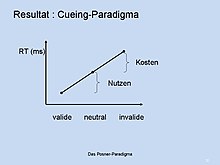Spatial cueing paradigm
The spatial cueing paradigm (. English spatial cue : location-based cue) by Michael Posner is part of one of the three existing approaches to explain the selective visual attention . In addition to the location-based approach, which also includes Posner's location-based cue paradigm , there are object-based and dimension-based approaches.
theory
Michael Posner shows that our visual attention is limited to a certain place of a defined size. The attention, called the spotlight, can be shifted arbitrarily or involuntarily. The assumption is that stimuli inside the spotlight are processed faster and more thoroughly than stimuli outside the spotlight. The concept of the spotlight was also taken up in Anne Treisman's feature integration theory.
The spatial cueing paradigm is preceded by a fundamental question that needs to be answered in the following: Does knowledge of the location where a visual signal will appear affect the efficiency of our information processing?
The paradigm
In the experiment, test subjects were asked to look at a fixation cross that was presented to them on a screen. This was followed by cues of an endogenous or exogenous nature, the informational content of which consisted of providing information about the probable location of the impending target stimulus.
Definition of cues
Under exogenous cues is to understand the spotlight a non-volitional orientation. This works automatically. This can be, for example, a flash of light that attracts our attention (spotlight).
An endogenous cue first requires an interpretation, on the basis of which the spotlight is oriented and functions in a controlled manner. This can be, for example, a directional arrow that draws our attention to one side of the display.
Possible states of the paradigm
1: the valid (valid) passage means that the target stimulus appears at the predicted location
- valid exogenous reference stimulus
- valid endogenous reference stimulus
2: the invalid (invalid) passage means that the target stimulus appears at the unpredicted location
- invalid exogenous reference stimulus
- invalid endogenous reference stimulus
3: the neutral passage takes place without a location-specific reference stimulus. Only a temporal warning signal (e.g. the flashing of the fixation cross) informs the test person about the target that appears to be the same.
Results
1. Endogenous cues: The diagram illustrates the reaction time to the target stimulus as a function of the cue stimulus condition. There is a benefit (reaction time gains) for valid rounds, because the cue stimulates the test subject to direct their location-based attention to the displayed location. This resulted in faster and more thorough stimulus processing within this visual field (spotlight). In contrast to this, there were longer reaction times (reaction time losses, costs) for the invalid passages because the target stimulus appeared at the non-indicated location and was therefore outside the spotlight. The response time gains and losses are relatively defined by the neutral condition.
2. Exogenous cues: The results vary depending on the duration of the fixation target interval. If the interval is <200 ms, the reaction times for valid cues are shorter, which indicates an advantage over invalid cues. If the interval increases, however, a disadvantage arises in the condition of the valid cues due to the phenomenon of "inhibition of return" - after leaving the point due to the elapsed time, attention cannot immediately be directed back to it, the point is, so to speak "Checked off", the disabled Targetcue now has an advantage.
Variations of the experiment
Any variations in the experimental conditions also produced similar results. As an example, the change in the shape of the target stimulus can be addressed, or the type of manual response (button or toggle switch), as well as the change in the time span between the presented cue and the target stimulus (ISI).
literature
- Jochen Müsseler; Wolfgang Prinz (Ed.): General Psychology . Spectrum Akademischer Verlag, Heidelberg et al. 2002, ISBN 3-8274-1128-9 ( spectrum textbook ).
- Hermann J. Muller, Patrick MA Rabbitt: Reflexive and voluntary orienting of visual attention: time course of activation and resistance to interruption. In: Journal of Experimental Psychology. Human Perception and Performance. 15, 1989, ISSN 0096-1523 , pp. 315-330, online (PDF; 1.62 MB) .
- Michael I. Posner, Charles R. Snyder, Brian J. Davidson: Attention and the Detection of Signals. In: Journal of Experimental Psychology. General. 109, 1980, ISSN 0096-3445 , pp. 160-174.








